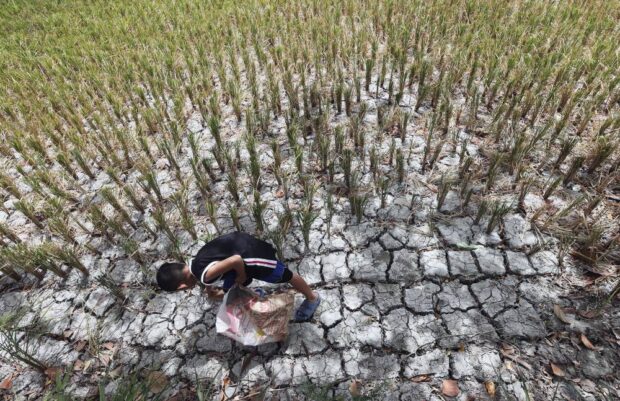El Niño may affect 20 percent of ricefields – NIA

PARCHED | In this photo taken in May 2023, a boy walks through a parched rice field in Tanza, Cavite, as the state weather bureau issued an El Niño alert. (File photo by MARIANNE BERMUDEZ / Philippine Daily Inquirer)
MANILA, Philippines — The National Irrigation Administration (NIA) is keeping a close watch on the rice fields of Central Luzon, the country’s rice granary, in anticipation of a decrease in production due to the effects of the prolonged drought this year, the agency’s administrator said on Wednesday.
In a television interview, NIA administrator Eduardo Guillen said they were projecting El Niño to affect 20 percent of the country’s rice farms, mainly due to an expected shortage of water for irrigation in Central Luzon.
“So the directive of [President Ferdinand Marcos Jr.] is for the NIA to push for the planting of high-yielding rice varieties in areas with ample irrigation because with these rice varieties, our farmers can increase their yield by as much as 50 percent to make up for the 20 percent of the land area that will have a lower yield,” he added.
Guillen made the disclosure as a response to Malacañang’s directive for agencies to come up with measures to allow the agriculture sector to adapt to the adverse impact of El Niño.
The NIA chief urged Filipino farmers to switch to high-yielding varieties, even as he clarified that the dry spell would not be much of a concern for rice crops.
Article continues after this advertisementHe cited how the country managed to stem the impact of a string of typhoons that hit rice-producing regions, which even supposedly allowed for an increase in production.
Article continues after this advertisement“That is the situation we are seeing in this case because ample sunlight is also favorable for rice,” Guillen said over the “Bagong Pilipinas Ngayon” government program.
According to him, an estimated 50,000 hectares of rice land in the province of Nueva Ecija, parts of Pampanga, Bulacan and Tarlac would be affected by the shortage of irrigation from the Pantabangan Dam, while another 30,000 hectares would be impacted in the rest of Central Luzon.
To address this, the NIA was also adopting an “alternate wetting and drying technology” which would supposedly require less irrigation and allow for an increase in yield by around 20 to 30 percent, Guillen said.
Farmers who would not be supplied with ample irrigation would receive assistance from the Department of Labor and Employment and the Department of Social Welfare and Development through the agencies’ cash-for-work programs, he added.
For rice farms in upland areas, the NIA will be installing a solar pump irrigation with “fertigation” and drip irrigation systems. Fertigation is the practice of applying fertilizer solutions with irrigation water, typically through a micro-sprinkler or a drip system.